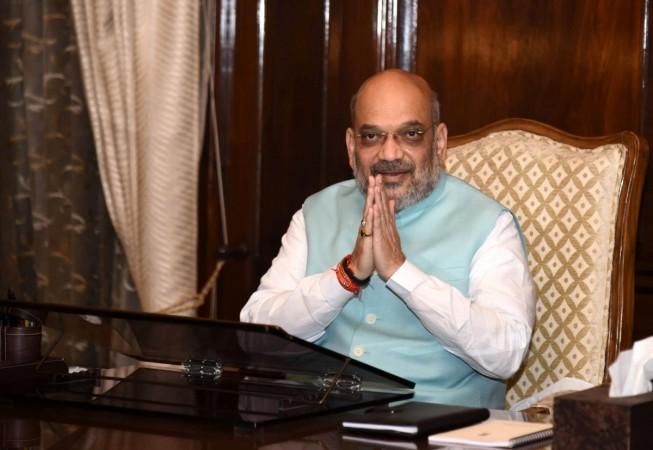
Home Minister Amit Shah has hit the ground running, as expected. With a catalogue of review meetings, Shah has many crucial things on his agenda including redrawing the long pending delimitation of constituencies in Jammu and Kashmir.
With President's Rule operational in the strife-torn state, Shah has already had a closed-door meeting with Governor Satyapal Malik. He also met Director, Intelligence Bureau Rajiv Jain and Home Secretary Rajiv Gauba. Almost in parallel, it is believed that the J&K Division in the vast swathe of Ministry of Home Affairs may be restructured.
The state has been under President's Rule since December 18, 2018. This is likely to be extended beyond July 3. The security forces have been flushing out local militants and have already notched up 100 kills in the year to date.
On the drawing board is believed to be the action plan for fresh delimitation of constituencies and appointment of a Delimitation Commission. At the very kernel of delimitation is redrawing the scope and size of Assembly constituencies and determine the number of seats to be reserved for SC.
This is, in the main to correct inequity and anomaly of regional disparity long suffered by Jammu province, and also provide representation to all reserved categories in the State Assembly.
The main grouse of Jammu being that growing imbalance emerging out of a composition of various constituencies would continue. Another section of thought is that Kashmir Valley claims that it has no SC or ST while Gujjars, Bakerwals and Gaddies were given Scheduled Tribe status in 1991 and form 11 per cent of the population but have no political reservation.
One needs to be mindful that the Constitution of Jammu & Kashmir, enacted in 1957, was based on the Maharaja's Constitution of Jammu & Kashmir of 1939, which was still in force. After accession to India, the State Constituent Assembly was constituted under the 1939 Constitution, but Sheikh Abdullah's administration arbitrarily carved out 30 seats for Jammu region and 43 seats for Kashmir region and two seats for Ladakh region. This regional disparity became entrenched thereafter: Kashmir (46), Jammu (37) and Ladakh (four).
Sometime in December 2016, a Cabinet Sub Committee on implementation of Agenda of Alliance of PDP-BJP government had referred the said issue of working out the modalities to a high-level bureaucratic panel. But this did not fructify.
During Ghulam Nabi Azad's term as Chief Minister, he had recommended a proposal of 25 per cent all-round increase in the number of Assembly seats of all three geographical regions in the state which would have resulted in an additional 22 constituencies in the Assembly. But PDP-Congress did not have the two-thirds heft in the Assembly and in any case NC had opposed it.
According to the 2011 census, the total population of Jammu Division was 5,378,538 of which Dogras were the dominant group comprising 62.55 per cent of the population. Jammu has 25.93 per cent of the area and 42.89 per cent of the population.
Against this, Kashmir Division or the intermontane valley population in 2011 was 6,888,475 with 96.40 per cent Muslims. Though it has 15.73 per cent of the state's area, it holds 54.93 per cent of the population. Ladakh has 58.33 per cent of the area accounting for 2.18 per cent of the population, a mere 274,289 people reside there of which 46.40 per cent are Muslims, 12.11 per cent Hindus and 39.67 per cent Buddhists.
The last time a delimitation exercise took place in the state was also under President's Rule, as far back as 1995 in extremely difficult circumstances by the Justice (retd) K.K. Gupta Commission. Incidentally, the Constitution provides for delimitation every 10 years, the next delimitation of Assembly constituencies should have logically taken place in 2005.
However, in 2002, the Farooq Abdullah government chose to freeze delimitation until 2026 by amending the Jammu & Kashmir Representation of the People Act 1957 and Section 47(3) of the Constitution of Jammu & Kashmir. The amended Section 47(3) provided "that until the relevant figures for the first census taken after the year 2026 have been published, it shall not be necessary to readjust the total number of seats in the Legislative Assembly of the State and the division of the State into territorial constituencies under this sub-section". This put the contentious matter in abeyance.
This is where the Governor comes in. On his intervention, this can be changed. For during President's Rule, the legislative authority is vested in the Governor. The last delimitation on the provisional basis was done in 1993 by Governor Jagmohan when J&K was divided into 87 Assembly constituencies.
The Governor is competent to amend section 47 of the Constitution to delete the objectionable proviso which barred the setting up of a Delimitation Commission. Furthermore, Section 3 of the Representation of the People Act gives the Governor the mandate to constitute a DC.
J&K has the powers to revoke the law through a Constitutional Amendment with a two-thirds majority and ramp up the number of seats. If the Governor sets up a Delimitation Commission, then the ball will start rolling. By fast-tracking it before the elections, some sort of common ground could be found.
At the moment there are seven seats reserved for Scheduled Castes in the Assembly, all in the Jammu Division which hasn't been rotated since 1996 - Chamb, Domana, Ranbir Singh Pura, Samba, Hiranagar, Chennai and Ramban (separate) in Jammu, Kathua and Udhampur districts, respectively.
Convention says that the next delimitation can only take place after Census 2031 unless the Governor intervenes and rectifies this irregularity. In another peculiarity, the State Constitution, under Section 48, reserves 24 seats in the 111-member Assembly for the area under Pakistani occupation (since 1947-48).









